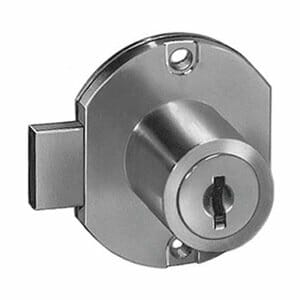About Disc Tumbler Locks
Slotted rotary detainer discs are the main part of most Disc Tumbler lock’s mechanisms, and they’re what set them apart from other designs of locks. Although Disc Tumblers are often confused with Wafer Tumbler locks, the two designs couldn’t be anymore dissimilar.

A specially designed key is used to operate a disc tumbler. The key turns the lock’s tumbler to line up with the slot, very much like those on a safe. This process tumbles the sidebar into the slots and opens the lock. Because a disc tumbler lock doesn’t use springs in its mechanism, unlike pin tumblers and wafer tumblers, it’s suited for installation on doors that are usually exposed to weather conditions and for securing public buildings.
A bit of history about Disc Tumbler Locks?
Till date, disc tumblers are still widely used to secure Finnish households and can be found on London doors as well. The locking mechanism was originally conceived in 1907 by Emil Henriksson, a Finnish scientist. But it was not until 1918 when the disc tumbler was first manufactured and mass produced by the Abloy Company.
Disc Tumbler Lock Design
A typical disc tumbler lock produced by Abloy usually features a hemi-cylindrical key that has notches. The lock also features detainer discs with holes that can vary between 180⁰ hemi-circle and a 270⁰ ¾ circle.
After the appropriate key is slid into a disc tumbler lock and twisted 90 degrees, the notches on the key will align at an angle to conform with corresponding angles in each hole that’s on the detainer disc.
How does a Disc Tumbler Lock work?
If you have in place a disc tumbler lock with a 270⁰ hole, its key will have to be 180⁰ in order to work with it. But if the hole is 240⁰, its key will have to be sized at 150⁰.
When the right sized key for a disc tumbler lock is slid into the locking mechanism and turned, every disc in the mechanism will rotate and align with the notches on the mechanism’s perimeter. Accomplishing this will drop the cylinder’s sidebar into the groove created by the disc’s notches and open the lock. But if an incorrect key is placed in a disc tumbler lock, its notches will not fit and this will cause the disc to rotate to a wrong angle and thus not unlock the mechanism.
To lock a disc tumbler, the key will be rotated towards the opposite direction. This will slide the sidebar into the cylinder’s opening and make use of the straight edge of the key to return the formerly scrambled position of the discs.
How secure are Disc Tumbler Locks?
The average disc tumbler lock can provide ample security to your London premises because of how tough they are to break or pick. This is especially true when compared to most other locks.
Because disc tumblers don’t make use of springs as part of their design, they are less likely to fall victim to rust or break down under wet weather.
Regarded by our locksmiths as a high-security lock, disc tumblers cannot be bumped. This makes them a fine choice for securing the doors of your home, business, or even your money drawers and closets for storing valuable equipment or documents. The more expensive versions of disc tumblers come with ‘false gates’ that trick burglars into thinking they’ve succeeded at picking its lock when they actually haven’t.
Cheaper disc tumblers can be forced open or broken apart because of the cheaper material they are made of. For a solid and yet fair priced disc tumbler lock that you can rely on for your London abode, our expert London locksmiths are available for both installations and repair. Our services are available around the clock and all year round.
How much do Disc Tumbler Locks cost?
The price of a disc tumbler lock is usually dependent on the model, the quality, and the material used in making it. Also, the more advanced the lock, the pricier it usually is. But keep in mind that the cheaper a lock is, the easier it will be to breach it because of its low quality.
For a well-priced disc tumbler lock that will be durable and reliable, contact our expert London locksmiths for a recommendation as well as efficient installation.
References:
Wafer Tumbler Lock, Pin Tumbler Lock, Lock Bumping, Lock Picking, Lock
